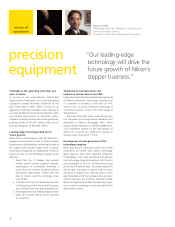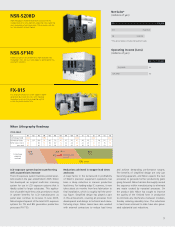Nikon 2005 Annual Report Download - page 20
Download and view the complete annual report
Please find page 20 of the 2005 Nikon annual report below. You can navigate through the pages in the report by either clicking on the pages listed below, or by using the keyword search tool below to find specific information within the annual report.
other
review of
operations
Strong sales rebound
contributes to smaller
operating loss
Strong sales rebound contributes to
smaller operating loss
Segment sales rose 11.6% year-on-year to ¥44,253
million. The operating loss shrank signifi cantly to
¥647 million, an improvement of ¥2,585 million
compared with the previous year. The leading
business developments were as follows.
1. Customized products posted higher sales
due to increased orders for aerospace-
related items and products used in semi-
conductor fabrication.
2. In new businesses, Nikon’s glass-related
operations posted higher sales from optical
components and optics-related materials.
3. Although sales of sport optics products
were fl at in Japan, increased sales of bin-
oculars and laser rangefi nders in the U.S.
market contributed to its overall growth.
4. Sales of ophthalmic products declined amid
depressed demand and fi ercer competition
in the markets for frames and sunglasses.
Aggressive development of new businesses
Nikon continued to pursue the development of
new business areas aggressively. In CMP systems
(chemical mechanical polishing systems designed
to make LSI chip surfaces even), Nikon attracted
more interest from chipmakers despite a delay
in the use of ultra low-k insulation materials,
which are the main target application. Nikon is
continuing to develop products for this market
while keeping a close eye on sector develop-
ments. In glass materials, Nikon is focusing on
expanding external sales including ultra-high-
grade silica glass, a fi eld in which it can exploit
its competitive edge. Elsewhere, Nikon has com-
menced full-scale production of optics engines
for LCOS-type rear-projection televisions, which
produce extremely high-quality images using
highly refl ective liquid crystal on silicon (LCOS).
Such televisions are gaining in popularity with
the increasing availability of digital full HD broad-
casts, and sales of these optics engines are
expected to grow going forward.
Other highlights
New laser rangefi nder with target priority
switch function
In September 2003, Nikon Vision Co., Ltd. launched
the Laser 500G rangefi nder. Laser rangefi nders are
portable devices that provide a quick and accurate
readout of the distance to an object by measur-
ing the time taken for an infrared laser beam to
be refl ected off it. Besides leisure applications in
golf and marine sports, laser rangefi nders are also
convenient tools for surveyors and civil engineers
for providing quick, easy measurements.
In the year ended March 2005, Nikon Vision
launched the Laser 800S. This model has a Target
Priority Switch System that allows users to switch
easily between two target-prioritization modes
to focus either on objects close to the viewer
or ones farther away. This function is useful in
various settings.
Launch of industrial lenses for high-
resolution CCD cameras
Accuracy requirements for circuit board inspec-
tion equipment are becoming more exacting as
printed circuits become increasingly complex and
intricate. Image-processing technology is now
the mainstream option for detecting defective
items in QC processes. Increasing complexity in
turn requires higher performance from the cam-
eras used in industrial circuit board inspection
equipment, producing demand for CCDs with
ultra-high resolution. Tochigi Nikon Corporation
manufactures and sells such high-performance
industrial lenses. Over the past year, the fi rm has
released a number of advanced lenses offering
high-resolution performance for the latest CCD
cameras. These include the Nikon Rayfact 80mm
F4 lens, the Nikon Rayfact 3.5x lens and the
Nikon Rayfact 7x lens (in June 2005).
HG L series binoculars
Laser 800S
Reducing distortion and aberration, this cutting-edge lens
is ideal for high-resolution CCD cameras, achieving superior
image quality even in peripheral areas.
Rayfact 7x
This device provides quick and accurate distance
measurement up to 730 meters (800 yards), and features a
Target Priority Switch System that allows users to select from
two measurement modes.
Designed for a broad range of outdoor applications, these new
HG L series binoculars feature the outstanding optical standards
of their predecessors while substantially reducing the weight of
42mm objective diameter models.
44,253
39,643
41,875
05
04
03
(647)
(3,232)
(1,260)
05
04
03
Operating Loss
(millions of yen)
Net Sales*
(millions of yen) * The below fi gures include
intersegment sales.
18
























